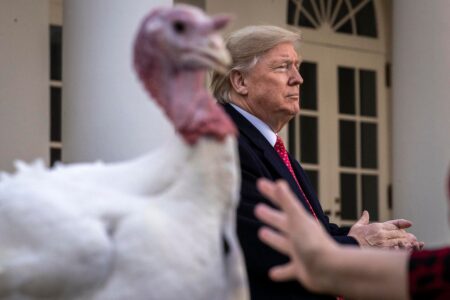Trump Takes Action on First Step Act
The First Step Act is a significant piece of criminal justice reform legislation signed into law by Donald Trump on December 21, 2018. The law was designed to address issues within the U.S. criminal justice system, particularly focusing on sentencing reforms, rehabilitation programs, and prison reform. The First Step Act is considered one of the most comprehensive changes to the criminal justice system in recent years.
Now, over six years since it passed, the Federal Bureau of Prisons (BOP) has still not fully implemented the program. Trump’s new BOP Director William Marshall III issued a press release stating that “President Trump said he would fight for the forgotten men and women of this country, and the First Step Act proved he meant it. Now, we are ensuring that this reform continues to work—not just as a policy, but as a promise to Americans seeking redemption and a path forward.” The press release went on to state that the BOP is expanding the use of home confinement to help further implement the First Step Act.
The First Step Act
The First Step Act implemented a system for earned time credits, where inmates could earn time off their sentence by participating in rehabilitation and vocational programs designed to reduce recidivism. Risk assessment tools were introduced to help determine which inmates were most likely to benefit from rehabilitation programs, and thus, which inmates were eligible for early release based on their progress.
First Step Act allows eligible prisoners to earn up to a year off of their federal sentences for successfully completing programming classes or productive activities. Each month, prisoners can take certain classes and participate in activities that can earn them up to 15 days/month. Once the prisoner earns a full year to reduce their sentence, the additional credits can be used for home confinement. For some prisoners, it could mean serving years of their sentence at home rather than in prison.
Halfway Houses and Second Chance
The use of halfway houses in the federal system goes back decades. The modern concept of halfway houses began to emerge with the rise of community-based correctional programs. The Omnibus Crime Control and Safe Streets Act of 1968 authorized funding for halfway houses as part of efforts to reduce overcrowding in prisons and offer more opportunities for inmates to reintegrate into society.
These facilities, operated by non-profit and for-profit entities contracted by the BOP, provide supervised housing and a transition to employment, education, and family reintegration.
Halfway house use expanded under the Second Chance Act, signed into law by President George W. Bush in 2008. The law focused on providing rehabilitation and reentry services to help ex-offenders successfully transition back into their communities. Under the law, prisoners could spend up to a year in prerelease custody (halfway house and home confinement) with up to a 6 months of that on home confinement.
Rocky Implementation of First Step Act
It took over 3 years after Trump signed the First Step Act before prisoners started to see any reduction in their sentences. In January 2022, the Final Rule was published in the Federal Register and it would take the BOP another 2 years to finalize how these credits are applied to reduce sentences. Under the leadership of former BOP Director Colette Peters, the BOP made great strides in fixing the calculator that had kept many prisoners incarcerated beyond the date they should have been released.
Over the past year, the BOP has done a better job of calculating those credits but a new problem arose, limited halfway house space. When the First Step Act was signed into law, the BOP knew that it would need additional capacity in halfway houses but a tight budget and the difficulty of adding new halfway houses proved to be a challenge. The BOP has stated that it has roughly 10,500 halfway house beds, which is approximately the same number they had when the First Step Act law was passed. As a result, not only was the BOP limited in the number of inmates it could send to halfway houses but the primary benefactors, First Step Act recipients, of more halfway house were those who did not really need the facilities of a halfway houses.
The First Step Act Primarily Benefits Non-Violent Offenders
To be eligible for the First Step Act a prisoner must have an offense that does not disqualify them. Terrorism charges, sex offenses and violence are among the 68 offenses that prevent prisoners from getting the full benefit of time off or more home confinement.
Those non-violent offenders also usually have shorter sentences and will return to their lives that are pretty much intact. Those who have been in prison for decades, usually have a rougher time acclimating back into society and halfway houses provide a resource to get a job, housing and reintegration back to society. Moving non-violent prisoners to home confinement makes sense from a fiscal standpoint since it is cheaper, but it also helps provide a space at a halfway house to someone who needs to get their feet under them after prison.
The BOP’s New Position
Director Marshall touted the policy as a move that “… reinforces the Bureau’s responsibility to uphold the law and ensure that eligible incarcerated individuals—particularly those who do not require transitional services at Residential Reentry Centers (RRCs)—are transferred to home confinement as soon as statutorily possible.”
While there are still some details being worked out, the new directive outlines the following expectations for staff:
- Home confinement is a priority for individuals who are eligible and do not require the structured support of a Residential Reentry Centers (halfway houses or RRCs). RRC placement will be reserved for those with the greatest need.
- Unit Teams must use FSA [First Step Act] and SCA [Second Chance Act] Conditional Placement Dates—based on projected Earned Time Credits (FTCs) expected to earn—to guide prerelease planning and ensure accurate and timely referrals.
- Staff must distinguish between FSA and SCA eligibility criteria, applying time credits appropriately and understanding the limits of each statute, particularly when determining duration of prerelease custody. There is no restriction concerning how many FTCs may be applied toward home confinement.
Challenges Remain
The BOP has yet to issue internal guidance but that will be released in the near future. What is uncertain is what will this mean for those incarcerated as it relates to when they will leave prison. The BOP has touted this directive as “expanding home confinement” but it may simply just limit the amount of time a person spends outside of the institution on prerelease custody.
As an example, a person with a 36 month sentence is eligible to earn 195 days under the First Step Act. They are also eligible for 365 days of prerelease custody with 101 days (10% of the imposed sentence) of Second Chance Act home confinement and the balance living in the halfway house. However, in its memo the BOP states that inmates “are transferred to home confinement as soon as statutorily possible.” According to the Second Chance Act, that is 101 days and because the inmate may not need halfway house placement, they will not be sent to the halfway house to live. Instead, they will remain in prison until they hit their home confinement date.
For those with longer sentences, say over 10 years, the inmate will only get home confinement for the additional First Step Act credits earned and nothing for Second Chance Act. Again, this seems to go against the “stacking” the BOP promised last year when they stated, and actually in many cases did so, that inmates could still get a large portion of Second Chance Act on top of First Step Act.
While it is promising that the BOP is recognizing the conditional or projected release date under First Step Act to place people in home confinement, it may not go as far as many advocated or prisoners believe it should. Those currently in halfway houses will likely move home confinement sooner, but it appears it will also leave many inmates in prison longer than they were hoping.
Read the full article here
















